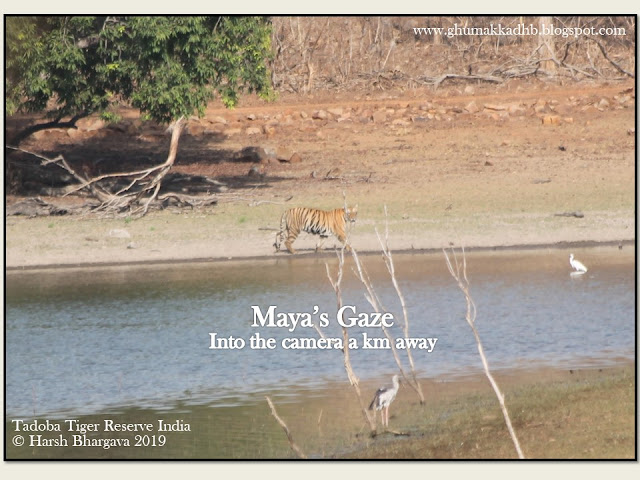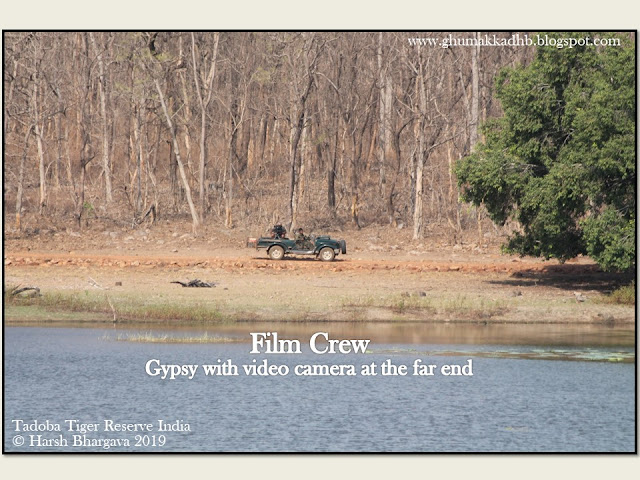Scene-1:
A tiger reserve.
With highest density per sq km.
Summer months.
Tigers have to come out to drink water.
So, if you visit in thick of summer, will you see a tiger?
Scene-2:
So, did you see a tiger in Tadoba?
Yes we did.
Did the Tiger enter water?
Yes.
Did it enter the water backwards?
Yes. But how do you know?
Well, why does a Tiger enter a lake or pond backwards?
Read on to find the answer.
When visiting a tiger reserve we have to remember that sighting a tiger is a matter of chance. And if it happens, it is only one part of the experience. The greater part is to be in the forest to be away from pollution, noise, concrete buildings, cell phones and other man-made distractions. In a forest we should be able to appreciate the trees, their canopy, arches, the flowers or the lack of flowers in a dry forest in summer.
We should be able to observe every tree, leaf, grass, shrubs, birds, their calls, other animals and the way they live with each other. You may like to browse our earlier story titled Tiger Ahoy! (click here) to get a feel of the excitement of being in a forest.
Being our fourth visit to Tadoba Andhari Tiger Reserve (TATR), it was no different. TATR over the years has added many features to its broad array of offerings. See the signage reproduced below which also gives the contact numbers.
All six of us wanted to see the Tiger the king of the jungle. Who were these crazy six, click here?
We started with the water points where tiger is expected to come in the searing heat of 47 degrees Celsius. Our first water point below.
Did we see the Tiger? No, but we did spot fresh pug marks.
That was encouraging. We pressed on to Telia water tank. Couple of Gypsy vehicles loaded with tourists arrived and waited as the Sun was already hot. Thirty minutes wait yielded no results. We spotted few Cheetals and new shoots springing out of dry branches.

While waiting for the tiger, our forest guide explained about the forest. Each safari vehicle has a trained forest guide. Both men and women carry out the duties of forest guides. The guide also ensures that mobile phones are not used during the safari. Camera permits are issued in advance for the lenses being used. Pictures.
A tiger reserve.
With highest density per sq km.
Summer months.
Tigers have to come out to drink water.
So, if you visit in thick of summer, will you see a tiger?
Scene-2:
So, did you see a tiger in Tadoba?
Yes we did.
Did the Tiger enter water?
Yes.
Did it enter the water backwards?
Yes. But how do you know?
Well, why does a Tiger enter a lake or pond backwards?
Read on to find the answer.
When visiting a tiger reserve we have to remember that sighting a tiger is a matter of chance. And if it happens, it is only one part of the experience. The greater part is to be in the forest to be away from pollution, noise, concrete buildings, cell phones and other man-made distractions. In a forest we should be able to appreciate the trees, their canopy, arches, the flowers or the lack of flowers in a dry forest in summer.
We should be able to observe every tree, leaf, grass, shrubs, birds, their calls, other animals and the way they live with each other. You may like to browse our earlier story titled Tiger Ahoy! (click here) to get a feel of the excitement of being in a forest.
Being our fourth visit to Tadoba Andhari Tiger Reserve (TATR), it was no different. TATR over the years has added many features to its broad array of offerings. See the signage reproduced below which also gives the contact numbers.
All six of us wanted to see the Tiger the king of the jungle. Who were these crazy six, click here?
We started with the water points where tiger is expected to come in the searing heat of 47 degrees Celsius. Our first water point below.
Did we see the Tiger? No, but we did spot fresh pug marks.
That was encouraging. We pressed on to Telia water tank. Couple of Gypsy vehicles loaded with tourists arrived and waited as the Sun was already hot. Thirty minutes wait yielded no results. We spotted few Cheetals and new shoots springing out of dry branches.
Males have to work hard to attract the attention of females- be it the birds or human beings! Story of getting ignored is the same.
We then decided to move to the second spot which was a transit point for one of the Tigers in the park. Another hour's wait but no joy. Few more spotted deers.

While waiting for the tiger, our forest guide explained about the forest. Each safari vehicle has a trained forest guide. Both men and women carry out the duties of forest guides. The guide also ensures that mobile phones are not used during the safari. Camera permits are issued in advance for the lenses being used. Pictures.
The safari duration is four hours from 5.30-9.30 AM. The visitors get a snack/bio break at a designated spot.
The forest has many ghost trees which shine at night! Feels eerie?
We then moved to Tadoba Lake where Maya with her grown up cubs had been sighted a day before. She was spotted under two large trees on other side of the lake.
The forest has many ghost trees which shine at night! Feels eerie?
We then moved to Tadoba Lake where Maya with her grown up cubs had been sighted a day before. She was spotted under two large trees on other side of the lake.
We sighted Maya almost a kilometre away. Even with a 300 mm lens she appeared to be no larger than a mouse. However, seeing a tiger in the wild evoked much excitement. More vehicles turned up to see Maya and her cubs getting into the lake and coming out frequently. To cool herself from searing heat. The pictures below also explain why do tigers enter the water backwards? We also saw few birds around the lake.
Here is a short 10-seconds video clip of Maya.
Here is a short 10-seconds video clip of Maya.
We were not allowed to go on the other side of the lake. However there was one loan Gypsy closer to the spot where Maya and her cubs were relaxing. On enquiry we were told that it was carrying a documentary filmmaker Mr Muthu who had been engaged by the forest department officially.
Talking of photography, there is always much to learn with every outing. More so if you have a teacher like this! See the picture below.
You may read our earlier story titled Maya's Maya here which has embedded video clips too.
You may read our earlier story titled Maya's Maya here which has embedded video clips too.
Here is another story on the oldest tiger of Tadoba, click to browse.
So next time when you go to a Tiger Reserve remember the signage below.
How to get there? Click here for driving directions. However, we would recommend taking NH-44 Nagpur Highway from Hyderabad and then turning east after Adilabad for Chandrapur.
Those coming by train from Delhi or Hyderabad have to get down at Chandrapur. There are no cabs at the railways station. However, you can take an auto to the taxi stand at Rs 30/- ride. Once at the taxi stand, plenty of cabs are available. You can bargain for Rs 800/- or so from Chandrapur to Tadoba MTDC where we stayed. It is 30 kms and takes about an hour. This info update is courtesy Aditya Jain who joined us from Delhi.
Safari Bookings continue to be done online. This is the first step in planning a trip to any of our Tiger Reserves in India. Each Safari permit is valid for up to six persons. However, please note that the names once entered can not be changed. One has to get a written permission from DFO Chandrapur for any change. We had to buy additional tickets for two members who had come as replacements, to ride in a 22-seater Canter. Previously, such changes were permitted except for team leader.
Buffer Zone Safaris are also to be booked online now. Till a year back, one could take a buffer zone safari on the spot. It shows rising demand for safaris specially in summer months. Tadoba is a perfect example of managing the man-animal conflict.
Budget: We four drove in a diesel car from Hyderabad to Tadoba and back. As mentioned earlier, we stayed at MTDC Moharli Resort which is value for money. We senior citizens got a discount on our Deluxe AC room tariff. For two nights stay, two safaris, to and fro travel from Hyderabad, all meals and all tips, the whole trip came to Rs 16,000/- per couple. Isn't that a steal?
We end this story with a picture of the safari trail.
We had two more sightings the same day i.e. 28th May 2019. Both in the afternoon! So, take your call and do plan an afternoon safari in end-May which is the hottest period every year. But you have to be well clad to protect yourself from extreme heat in the afternoon.
We end this story with a picture of the safari trail.
We had two more sightings the same day i.e. 28th May 2019. Both in the afternoon! So, take your call and do plan an afternoon safari in end-May which is the hottest period every year. But you have to be well clad to protect yourself from extreme heat in the afternoon.
Thanks for browsing.
- Harsh-the-Ghumakkad with Neeta Bhargava/ 10th June 2019
Postscript: Animesh Bhowmick wrote "Tigers are overall part of complete forest eco-system, though at the top of the chain and must be seen like that. You save Tigers, you protect complete eco-system including the human being in the buffer zone. Tadoba happens to be one of the seven or eight Tiger Reserves in Central India with more or less similar eco-system, with small variations and connected Tiger corridors. Try to enjoy the flavour of each of them"
- Harsh-the-Ghumakkad with Neeta Bhargava/ 10th June 2019
Postscript: Animesh Bhowmick wrote "Tigers are overall part of complete forest eco-system, though at the top of the chain and must be seen like that. You save Tigers, you protect complete eco-system including the human being in the buffer zone. Tadoba happens to be one of the seven or eight Tiger Reserves in Central India with more or less similar eco-system, with small variations and connected Tiger corridors. Try to enjoy the flavour of each of them"
#tigerreserve #tadoba #tigersighting #forests #junglesafari #mayathetigress #tigerbajrang #sonamthetigress #india #wildlife #ghumakkadhb #ghumakkadharsh #pugmarks #tigercubs
























































Wonderful pictures and narrative.
ReplyDeleteThanks much Debu. Coming from an ace photographer, it means a lot🙏
DeleteGreat photos and narration !!! Sir as I said on 3 Jun, I was waiting eagerly for this.Enjoyed!!! Last Sept we went to Tadoba with Mr Rushad Mistry ( a wild life enthusiast, biker, aviator and traveller). We could spot Gaurs, Blue Bulls, snakes, Langurs, lot of bird and nests with chicks,a crocodile in lake, odd wild boar. Your photographs are prompting me to go again to spot a tiger!! Great time in extreme heat. Kudos sir
ReplyDeleteThanks much Parag. Yes, September would have been a much greener and cooler climate in Tadoba. But alas Tiger eluded the visitors then. Being located so close by, you should plan a visit in end-May next year. It would be rewarding! Hopefully as the cartoon in our story said!
DeleteWonderful narration, Harsh. Somehow I could not see the photos on my computer
ReplyDeleteStrange. Could you see it on your mobile through the link sent on our BITS WA group?
DeleteAmazing story
ReplyDeleteCaught both my curiosity and imaginaation
ReplyDeleteThanks much Ron. Appreciate.
DeleteTadoba nostalgic. Stayed at the forest rest house and missed the Tiger by a minute. You are lucky to have spotted 3 of them.
ReplyDeleteThanks much fellow Tiger lover. Am sure you will be luckier the next time.
DeleteExcellent coverage with good comentary and accompaning photographs. Finally excellent guidance for people who would love to visit. Good job. Keep it up.
ReplyDeleteThanks much Ravindra. Appreciate your feedback.
DeleteWas exited to see the photos. I was recollecting my journey in Nagarahole forest, Karnataka. Nice experience sir.
ReplyDelete